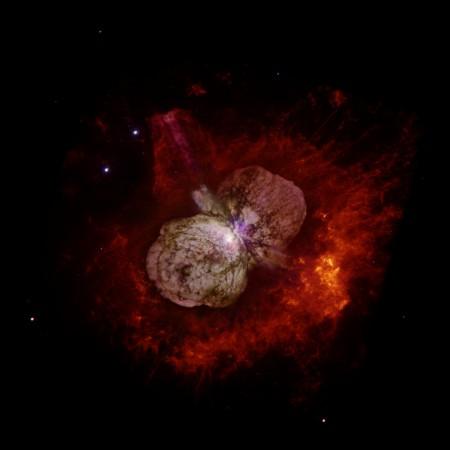
NASA's NuSTAR space telescope has found that - the brightest and most massive star system within 10,000 light years away is sending particles outward from it at massive energy levels and some of it could hit Earth in the form of cosmic rays.
In a report published by the space agency, it was found that the star system which is about 7,500 light years away and is seen as part of the constellation Carina. Being a binary star system, it contains a pair of stars, both of which are much larger than the Sun and of the stars within 10,000 light years from Earth they are the brightest. In the 19 century, they were briefly the brightest stars in the sky, seen as one star in the night, because of a powerful outburst which created an hourglass-shaped nebula, for reasons that are yet to be understood by astronomers.
Kenji Hamaguchi, an astrophysicist at NASA's Goddard Space Flight Center and lead author of this study, spoke of how this team, "... know the blast waves of exploded stars can accelerate cosmic ray particles to speeds comparable to that of light, an incredible energy boost," while adding how "Similar processes must occur in other extreme environments. Our analysis indicates Eta Carinae is one of them."
Over the last five and half years, both stars that make up the binary, came about 230 million kilometres of each other. This is about the average distance between Mars and the Sun. When bodies of this size get so close to each other, they undergo a series of processes that end with them churning and spewing a massive quantities of cosmic rays, says the report.
When cosmic rays are recorded with energy levels greater than a billion electron volts (eV), it is recognised as originating from beyond the Solar System, says NASA. It is however, quite difficult to find out exactly where the rays are coming from because cosmic rays and the particles that make up parts of it all carry electrical charges and every time they come near or interact with magnetic fields, they veer off and get scrambled.
Fiona Harrison, the principal investigator of NuSTAR said that the team already knew for some time that the region around Eta Carinae is a source of energetic emission in high-energy X-rays and gamma rays. "But until NuSTAR was able to pinpoint the radiation, show it comes from the binary and study its properties in detail, the origin was mysterious."
The study was first published in the journal Nature Astronomy.
















